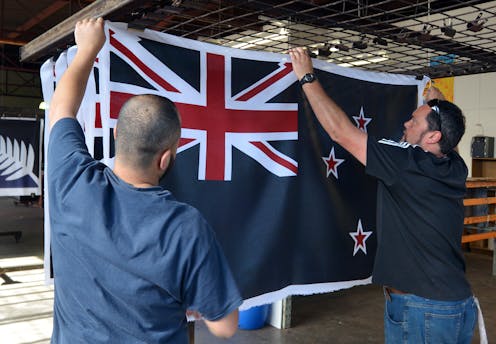'Courageous' investment means innovation stays in NZ, not sold off overseas
- Written by Jessica C Lai, Associate Professor in Commercial Law, Te Herenga Waka — Victoria University of Wellington

New Zealand is in an economic recession[1] and the government is trying to spend its way through it with direct investment[2] to boost the economy and jobs.
At the same time, the Reserve Bank of New Zealand (RNBZ) plans[3] to lend retail banks money at low interest rates in the hope they are — as the reserve bank governor, Adrian Orr, put it — “courageous[4]” in their lending choices.
But as the money does not need to be used for any particular type of venture, there are concerns it will inflame the already overheated property market[5].
Part of the problem is New Zealanders do not have many investment options. There is little to be “courageous” about.
This lack of investment options is partly due to the average New Zealander’s model of successful innovation.
Read more: With house prices soaring again the government must get ahead of the market and become a 'customer of first resort'[6]
Most of the big successful New Zealand innovation stories we see in the media[7] are about people who sold their innovation to an overseas – typically American – company. This success allows the innovator to buy their “three Bs[8]”: the Beamer, the boat and the bach.
But is this a true measure of successful innovation? Or could we do better to create more investment options and allow for more “courageous” investment?
Investment in local industry
Innovation involves creating and capturing value from new things – whether products, services or processes.
The New Zealand model of successful innovation is narrowly about creation, perhaps setting up and then selling a start-up. This model is shaped by skill shortages, funding issues and risk aversion[9], which limit innovative growth.
Big ideas struggle to grow in New Zealand. The model is about innovators capturing short-term value for their creations.
What might be truly beneficial to New Zealand is if innovations stayed here and more risks were taken locally.
If more investment was directed at commercialisation of local innovations they could be used to create and grow local industries[10]. The resulting products or services could then be exported or licensed internationally to bring more wealth into New Zealand.
This would create more investment opportunities, as well as jobs and local know-how. In turn, wealth could be created and distributed across communities for a sustained period.
It’s worth pointing out that innovation is self-perpetuating. Once an innovative industry is developed in an area, this can generate further innovation in that area, because of skill development and the localisation of these skills. Silicon Valley[11] exemplifies this.
Learn from the Māori perspective
We need not look far to find an alternative model of successful innovation.
Talk to Māori communities and you hear that successful innovation is something that is implemented locally and creates value throughout the community[12].
During community consultation to develop Te Matarau a Māui[13] – a regional Māori economic development strategy for the greater Wellington region – we were told time and again that the common strategic goal of “play to win” was too narrow.
A Māori perspective on innovation doesn’t focus on winners and losers, but on a vibrant blossoming innovation ecosystem. Innovation from this perspective is tied up with cultural knowledge and community identity.
This kind of innovation model leads to better distributed and long-term wealth creation, since value is embedded within and spread throughout the community.
Yet the tools, such as the Business Model Canvas[14], that we use to explore business ideas are based on hyper-individualistic, win-at-all-costs businesses.
New Zealand needs entrepreneurship and innovation tools that embed a richer perspective on success[15], more in line with the aspirations of the wellbeing economy[16] and the Māori communities that developed Te Matarau a Māui.
A look to the future
We are not saying individual innovators should not be rewarded for their innovations. They should be. Nor are we saying that there aren’t success stories that involve local commercialisation. There are.
Moreover, we are not suggesting New Zealanders do not look outwards. They absolutely should.
But perhaps New Zealanders could shift their understanding of a success story for innovation, because we could have more innovation stories that involve further growth and benefit the well-being of communities.
Such a shift cannot happen until there is money to undertake the necessary risk to produce Kiwi innovations locally. International intellectual property portfolios should be developed in important markets, but we should invest in local capabilities to maintain operations in New Zealand. This would feed the New Zealand economy.
Read more: New data privacy rules are coming in NZ — businesses and other organisations will have to lift their games[17]
More provocatively, keeping innovations local would create more business opportunities that New Zealanders could invest in, aside from real estate. Perhaps this could help to cool down the property market.
So in light of RBNZ’s role[18] to “promote the prosperity and well-being of New Zealanders”, contribute to a “sustainable and productive economy” and support[19] “maximum sustainable employment”, perhaps it should think about tying its lending scheme to making sure local innovation stays local. Otherwise, we might be letting a good crisis go to waste.
References
- ^ economic recession (www.newshub.co.nz)
- ^ direct investment (www.beehive.govt.nz)
- ^ plans (www.rnz.co.nz)
- ^ courageous (www.nzherald.co.nz)
- ^ already overheated property market (www.rnz.co.nz)
- ^ With house prices soaring again the government must get ahead of the market and become a 'customer of first resort' (theconversation.com)
- ^ we see in the media (www.stuff.co.nz)
- ^ three Bs (www.newshub.co.nz)
- ^ Beyond ‘the Beamer, the boat and the bach’? A content analysis-based case study of New Zealand innovative firms (researchcommons.waikato.ac.nz)
- ^ Beyond ‘the Beamer, the boat and the bach’? A content analysis-based case study of New Zealand innovative firms (researchcommons.waikato.ac.nz)
- ^ Silicon Valley (www.researchgate.net)
- ^ implemented locally and creates value throughout the community (www.callaghaninnovation.govt.nz)
- ^ Te Matarau a Māui (www.tematarau.co.nz)
- ^ Business Model Canvas (eship.ox.ac.uk)
- ^ embed a richer perspective on success (www.dropbox.com)
- ^ wellbeing economy (www.treasury.govt.nz)
- ^ New data privacy rules are coming in NZ — businesses and other organisations will have to lift their games (theconversation.com)
- ^ RBNZ’s role (www.legislation.govt.nz)
- ^ support (www.rbnz.govt.nz)
Authors: Jessica C Lai, Associate Professor in Commercial Law, Te Herenga Waka — Victoria University of Wellington












